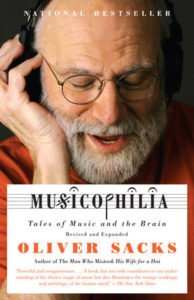British neurologist Oliver Sacks describes in a scientific and humanistic way the effect of sounds and music on the mind. The author tells, for example, the story of a man whose musical talent emerges after he is struck by lightning, the experience of a Sicilian woman who experienced epileptic seizures when listening to Neapolitan songs, the testimony of a musical savant who knows more than two thousand operas by heart, and the day-to-day life of a severe amnesiac who remains anchored to life through music. The tales are so curious and intriguing that it is difficult to choose between them.
Sacks’ neuroscientific research brings together illustrative cases, clinical trials, accredited studies, autobiographical experiences, letters and testimonials. It is fair to say that ‘Musicophilia’ reveals an insatiable eagerness to understand what happens in the brain when music is listened to, performed, or felt.

Throughout the book there are two main streams. On the one hand, the pathogenic effects of sound are studied. On the other, the beneficial and healing role that music plays in life is explored.
‘Musicophilia’ is composed of four major sections, which we present below:
Part I: ‘Haunted by Music’
In the first section of the text, Dr. Oliver Sacks focuses on Musicogenic Attacks. He demonstrates how music can lead to complex disorders and can be both frightening and harmful. Among the most curious anomalies are:
-
Musicogenic Epilepsy
The author presents clinical histories in which a musical stimulus is capable of triggering an epileptic seizure. Some patients say that the music seems to be an essential part of the attack, as it becomes intense, overwhelming, and exerts enormous power over them.
In this altered state, there are those who suffer from complex seizures, bite their tongues, lose consciousness, and become incontinent.
Sacks’ research also indicates that the epileptic condition can be induced by nonspecific musical fragments (of varied origin), emotional songs, tones, rhythms, unexpected or high intensity sounds, and screeching noises, among others.
-
Imagery and Imagination
The British writer explains that many people possess the important ability to mentally and vividly reproduce music for which they feel a special affinity. These are people who can precipitate their musical imagination, as if they had an orchestra or a radio station in their head.
Ludwig van Beethoven is the best example of this type of musical imagery. And the fact is that, even when deaf, this extraordinary composer used his deliberate and conscious imagination to continue creating profoundly expressive pieces.
This chapter focuses mainly on the study of Involuntary Musical Imagery. A curious condition in which music appears in an unexpected, intrusive, and apparently inexplicable way.
While it is true that people can remember a song just for fun, or by mere chance, specialists do not disregard the idea that the subconscious part of the mind tries to communicate all kinds of insinuations through music.
According to Sacks’ findings, the melodies that resonate within each human being tend to reveal something of their own nature. Apparently, they can arise to: externalize moods, evoke memories, highlight longings, or manifest repressed desires.
-
Brainworms
The author compiles tales of people tormented by melodies or musical fragments that repeat over and over again in their heads. This is the phenomenon of Brainworms, a pathological version of musical imagination.
Brainworms usually appear suddenly and become compulsively and irresistibly hooked in the mind. It is as if the subject is trapped in a musical loop that can be perpetuated for hours or days. In certain cases, this incessant bombardment of melodies can incapacitate the sufferer.
It is noteworthy that these worms are activated more frequently when the musical composition is simple, repetitive, and with rhythmic patterns that are easy to memorize.
-
Musical Hallucinations
Dr. Sacks indicates that Musical Hallucinations consist of a type of subjective experience in which an individual listens to music (or aspects of it) without the presence of external stimuli.
In this case, it is not a type of musical imagery that usually resonates within people. Those who experience auditory hallucinations can have the false belief that the music they “hear” comes from a material source, such as a music player or a television.
Although the neurological process of this pathology is not entirely clear, so far it has been demonstrated that: a) Musical hallucinations are relentless and involuntary mental intrusions, b) They seem to act on their own and occur with low frequency, c) The repertoire of hallucinations usually varies according to each subject, d) They are shown with higher incidence in patients with hearing loss, advanced age, or brain lesions.
Part II: ‘A Range of Musicality’
In the second part of ‘Musicophilia’, a series of cases of individuals who have experienced alterations in their musical qualities and abilities are brought together. Among the crucial findings on Musicality are:
-
Amusia
This chapter covers interesting stories of people unable to understand or enjoy music for what it is.
It should be noted that persons with Amusia present important imbalances in the perceptual and cognitive mechanisms essential for making and appreciating music. This means that those affected cannot accurately distinguish elements such as tone, rhythm, tempo, timbre, or volume.
In the most extreme cases, patients come to perceive music as an irritating, unpleasant sound, capable of generating discomfort and pain.
-
Synesthesia and Music
The research suggests that there are a surprising number of people with the ability to perceive music through different senses, such as as a color, smell or taste.
Some professional musicians emphasize that synaesthetic colors are very useful for creative thinking and composition. For them, sound is inextricably fused to color.
Part III: ‘Memory, Movement, and Music’
In the third section of the book, Oliver Sacks optimistically highlights the therapeutic value of music.
In page after page, the author offers numerous testimonies of people with serious neurological conditions who, thanks to music therapy, are able to alleviate their ailments or overcome their limitations. He talks about, for example, aphasic individuals who recover the ability to communicate verbally, people with Tourette ‘s syndrome who channel their energy by playing drums; Parkinsonians who dance tango in order to improve their balance and mobility, and frontal lobe lesion patients who use musical rhythm to recover movement, to mention a few.
Part IV: ‘Emotion, Identity, and Music’
“Music, uniquely among the arts, is both completely abstract and profoundly emotional. It has no power to represent anything particular or external, but it has a unique power to express inner states or feelings. Music can pierce the heart directly; it needs no mediation”, Sacks writes.
In the last part of the book, the close link between music and human emotions is explored and unraveled. Cases of individuals completely indifferent to music (Musical Anhedonics), as well as hypermusical people, stand out.
It is worth noting that there is an entire chapter devoted to musical dreams. Although there is little research on this subject, it is known that this type of dreaming is immune to distortions of the mind. Usually, when a person dreams of melodies, he or she is able to perceive them clearly and accurately.
Important classical composers such as Handel, Mozart, Chopin and Brahms used their dreams as inspiration. Apparently, there are people capable of composing original music in their sleep.
The Sacks legacy
It can be said, without fear of exaggeration, that neurologist and writer Oliver Sacks has left an imponderable legacy. ‘Migraine’, ‘Awakenings’, ‘The Man Who Mistook His Wife for a Hat’, ‘An Anthropologist on Mars’ are just some of his best known works.
Despite the clinical descriptions and scientific content, ‘Musicophilia: Tales of Music and the Brain’, is an enjoyable text. Beyond theory, this prolific author deals with narration from a sensitive and human perspective.
I recommend this book to anyone who is fascinated by the mysterious and complex relationship between music and the brain.
Image credit: Nappy

